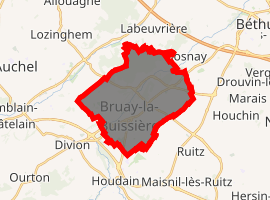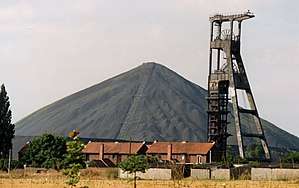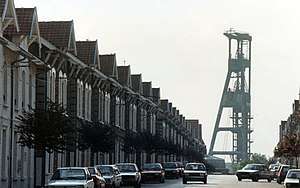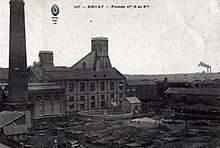Bruay-la-Buissière
Bruay-la-Buissière is a commune in the Pas-de-Calais department in the Hauts-de-France region in northern France.
Bruay-la-Buissière | |
|---|---|
A general view of Bruay-La-Buissière | |
 Coat of arms | |
Location of Bruay-la-Buissière 
| |
 Bruay-la-Buissière  Bruay-la-Buissière | |
| Coordinates: 50°28′55″N 2°32′55″E | |
| Country | France |
| Region | Hauts-de-France |
| Department | Pas-de-Calais |
| Arrondissement | Béthune |
| Canton | Bruay-la-Buissière |
| Intercommunality | CA Béthune-Bruay, Artois-Lys Romane |
| Government | |
| • Mayor (2020–2026) | Ludovic Pajot (RN) |
| Area 1 | 16.35 km2 (6.31 sq mi) |
| Population (2017-01-01)[1] | 21,831 |
| • Density | 1,300/km2 (3,500/sq mi) |
| Time zone | UTC+01:00 (CET) |
| • Summer (DST) | UTC+02:00 (CEST) |
| INSEE/Postal code | 62178 /62700 |
| Elevation | 30–106 m (98–348 ft) (avg. 98 m or 322 ft) |
| 1 French Land Register data, which excludes lakes, ponds, glaciers > 1 km2 (0.386 sq mi or 247 acres) and river estuaries. | |
Geography


A former coalmining town some 6 miles (9.7 km) southwest of Béthune and 30 miles (48.3 km) southwest of Lille, at the junction of the D57 and the N47 roads.
History
With four coal mines, it was the headquarters of the Bruay Mining Company. The coal mines closed during the 1960s, to be replaced by light industrial work and chemical factories. In April 1972 the murder of miner's daughter Brigitte Dewevre became a politicized event when Pierre Leroy, a local middle-class lawyer associated with the local mining company, was arrested: La Cause du Peuple, the paper of the Maoist Gauche prolétarienne, publicized the case with the headline 'Bruay: And Now They Are Massacring Our Children!'[2]
The two places of Bruay-en-Artois and La Buissiere were joined as one commune in 1987.

Population
| Year | Pop. | ±% |
|---|---|---|
| 1962 | 30,982 | — |
| 1968 | 32,341 | +4.4% |
| 1975 | 29,435 | −9.0% |
| 1982 | 26,649 | −9.5% |
| 1990 | 24,927 | −6.5% |
| 1999 | 23,998 | −3.7% |
| 2009 | 23,621 | −1.6% |
Sights
- The Hotel de Ville (Town Hall), 47 m tall built in 1927. The windows recount scenes from the lives of miners.
- The Art Deco swimming pool, built in 1936 (the last remaining Art Deco pool open to the public)
- The Museum of mining.
- The Church of Saint Martin, dating from the fifteenth century, was expanded and renovated in 1974.
- Ballencourt manor in La Buissière, was built in 1777. Partially renovated, it now hosts the music school.
- The donjon of the castle of La Buissière, built in 1310 by Mahaut, Countess of Artois.
- The church at La Buissière, presently closed to the public for renovation work.
- The Velodrome at La Buissière built by the Bruay Mining Co., in 1925.
- The Museum of calculation and Scripture. Traces the history of writing and calculating machines such as the Enigma German coding machine.
References
- "Populations légales 2017". INSEE. Retrieved 6 January 2020.
- La Cause de Peuple, 1 May 1972. Cited in 'Showdown at Bruay-en-Artois', ch. 1 of Richard Wolin, The Wind from the East: French Intellectuals, the Cultural Revolution, and the Legacy of the 1960s, Princeton University Press, 2010.
External links
| Wikimedia Commons has media related to Bruay-la-Buissière. |
- The CWGC graves in the Bruay-la-Buissière communal cemetery
- Official website of the commune (in French)
- A website about the commune (in French)
- The website of the intercommunality (in French)
- Website of the Communauté du Bruaysis (in French)
- Bruay-la-Buissière on the Quid website (in French)